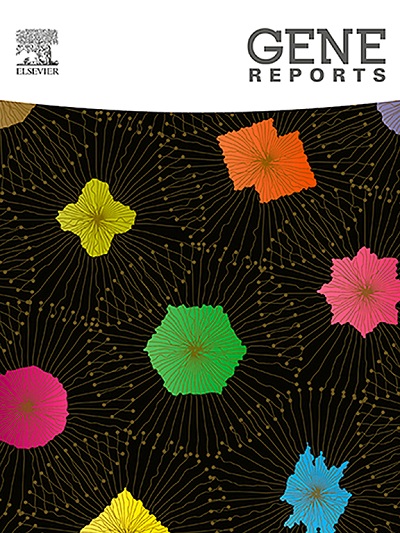Reduced expression of insulin like growth factor-2 mRNA binding protein 2 (IMP2) elevates TAZ via IMP3 in triple-negative breast cancer
IF 1
Q4 GENETICS & HEREDITY
引用次数: 0
Abstract
Insulin like growth factor-2 mRNA binding proteins IMP2 and IMP3 are usually expressed in aggressive triple-negative breast cancer (TNBC). Although, IMP3 plays a pro-tumorigenic role in breast tumors, function of IMP2 is less clear. Therefore, the objective of this study is to understand the functions of IMP2 in breast cancer. Using published mRNA and proteomic databases, we show that expressions of IMP2 and IMP3 correlate well in breast tumors. One of the important mechanisms by which IMP3 contributes to TNBC progression is its ability to activate TAZ oncoprotein via LATS1 and WNT5B. Surprisingly, short hairpin RNA (shRNA) mediated depletion of IMP2 protein increased TAZ and WNT5B expression in TNBC cells. We also noticed a decrease in phospho-LATS1. This observation is surprising because both IMP2 and IMP3 proteins are structurally very similar and are expressed together in TNBC. Moreover, we discovered that IMP2 depletion increased IMP3 expression which in turn enhanced TAZ and WNT5B level. Although both IMP2 & IMP3 interacts physically as evident from the co-immunoprecipitation experiment, the mechanism behind this reciprocal regulation is not clear at this point. Further, our analysis of a proteomic database identified proteins (notably SOX10, S100A9, SLC7A5 and ARG1) that are significantly elevated in TNBCs that express relatively higher IMP2 (IMP2high) compared to IMP2low tumors. Despite a strong positive correlation with IMP2, expressions of these genes are also increased in IMP2-depleted cells. Importantly, these genes are associated with poor patients survival. In conclusion, IMP2 seems to play a tumor suppressive role in TNBC cells.

胰岛素样生长因子-2 mRNA结合蛋白2 (IMP2)在三阴性乳腺癌中的表达减少通过IMP3升高TAZ
胰岛素样生长因子-2 mRNA结合蛋白IMP2和IMP3通常在侵袭性三阴性乳腺癌(TNBC)中表达。虽然IMP3在乳腺肿瘤中起促瘤作用,但IMP2的功能尚不清楚。因此,本研究的目的是了解IMP2在乳腺癌中的功能。利用已发表的mRNA和蛋白质组学数据库,我们发现IMP2和IMP3的表达在乳腺肿瘤中有很好的相关性。IMP3促进TNBC进展的重要机制之一是其通过LATS1和WNT5B激活TAZ癌蛋白的能力。令人惊讶的是,短发夹RNA (shRNA)介导的IMP2蛋白缺失增加了TNBC细胞中TAZ和WNT5B的表达。我们还注意到phospho-LATS1的减少。这一观察结果令人惊讶,因为IMP2和IMP3蛋白在结构上非常相似,并且在TNBC中一起表达。此外,我们发现IMP2缺失增加了IMP3的表达,进而增加了TAZ和WNT5B的水平。尽管IMP2 &;从共免疫沉淀实验中可以看出,IMP3在物理上相互作用,但这种相互调节背后的机制目前尚不清楚。此外,我们对蛋白质组学数据库的分析发现,与imp20低的肿瘤相比,在表达相对较高的IMP2(高)的tnbc中,蛋白(特别是SOX10、S100A9、SLC7A5和ARG1)显著升高。尽管与IMP2呈正相关,但这些基因的表达在IMP2缺失的细胞中也增加。重要的是,这些基因与不良患者的生存有关。综上所述,IMP2似乎在TNBC细胞中发挥肿瘤抑制作用。
本文章由计算机程序翻译,如有差异,请以英文原文为准。
求助全文
约1分钟内获得全文
求助全文
来源期刊

Gene Reports
Biochemistry, Genetics and Molecular Biology-Genetics
CiteScore
3.30
自引率
7.70%
发文量
246
审稿时长
49 days
期刊介绍:
Gene Reports publishes papers that focus on the regulation, expression, function and evolution of genes in all biological contexts, including all prokaryotic and eukaryotic organisms, as well as viruses. Gene Reports strives to be a very diverse journal and topics in all fields will be considered for publication. Although not limited to the following, some general topics include: DNA Organization, Replication & Evolution -Focus on genomic DNA (chromosomal organization, comparative genomics, DNA replication, DNA repair, mobile DNA, mitochondrial DNA, chloroplast DNA). Expression & Function - Focus on functional RNAs (microRNAs, tRNAs, rRNAs, mRNA splicing, alternative polyadenylation) Regulation - Focus on processes that mediate gene-read out (epigenetics, chromatin, histone code, transcription, translation, protein degradation). Cell Signaling - Focus on mechanisms that control information flow into the nucleus to control gene expression (kinase and phosphatase pathways controlled by extra-cellular ligands, Wnt, Notch, TGFbeta/BMPs, FGFs, IGFs etc.) Profiling of gene expression and genetic variation - Focus on high throughput approaches (e.g., DeepSeq, ChIP-Seq, Affymetrix microarrays, proteomics) that define gene regulatory circuitry, molecular pathways and protein/protein networks. Genetics - Focus on development in model organisms (e.g., mouse, frog, fruit fly, worm), human genetic variation, population genetics, as well as agricultural and veterinary genetics. Molecular Pathology & Regenerative Medicine - Focus on the deregulation of molecular processes in human diseases and mechanisms supporting regeneration of tissues through pluripotent or multipotent stem cells.
 求助内容:
求助内容: 应助结果提醒方式:
应助结果提醒方式:


